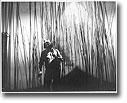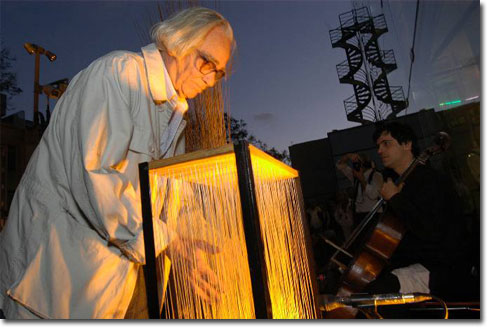Centro Cultural Recoleta ,
Dec 16, 2004 - Feb 27, 2005
Buenos Aires, Argentina
León Ferrari: Retrospective. Works 1954-2004
by Viviana Usubiaga
Leon Ferrari is without a doubt one of Argentina's most prolific artists. He's currently demonstrating this by holding simultaneous exhibitions of his vast production, the largest of which is the retrospective exhibition curated by Andrea Giunta at the Recoleta Cultural Center in the city of Buenos Aires: Leon Ferrari: Retrospectiva. Obras 1954-2004. The multireferentiality in his work and his untiring energy allow him also to take part in the exhibitions Entre el silencio y la violencia. Arte contemporaneo argentino, curated by Mercedes Casanegra, at the Espacio Fundacion Telefonica; Leon Ferrari. Artefactos para dibujar sonidos; Contemporneo 11: La Re-coleccion, a collection of contemporary Argentine art formed by the artists Fernando Brizuela, Mariano Dal Verme and Beto de Volder, and in the segment dedicated to the sixties/seventies period at Malba, Donaciones, adquisiciones y comodatos, these last three at the Museum of Latin American Art in Buenos Aires. Constantini Collection. Tracing Leon's steps
Ferrari was born in Buenos Aires in 1920 and studied engineering at the University of Buenos Aires and worked in his profession until 1976. In 1954, while living in Italy, he began to make ceramic vases and sculptures at an old vase factory in Rome. From the beginning of his artistic activities he was prepared to try different materials: oil paintings, sculptures in plaster, cement, wood, clay and steel wire; drawings, graphs, collages, objects, recordings of the most assorted kinds, assemblages, mail art, video. In 1958/59 he produced a film entitled La primera fundacion de Buenos Aires with script and direction by Fernando Birri. Dealing with a illustrator by the name of Oski, this feature-length film received three national awards and represented Argentina at the 1959 Cannes Festival. In 1976 he was exiled with his family to Brazil, returning to Buenos Aires in 1991. A review of the works of Leon Ferrari reflect changing and multiplying reflections of a single principle or series of ethical principles which defy modern Western morality. The respect for difference, the condemnation of violence, the evidence of a society disciplined by the imposition of official religious, legal, aesthetic and State discourses, are the grounds for his work and illuminate aspects of his artistic-political engagement. In his broad selection of materials and subject matter as well as in the chosen methods of production, reproduction and situation, Ferrari takes charge of widening the margins of artistic space. His sharp criticism of the functions complied with by the artists and images most consecrated in the history of art extend to the contemporary uses of imagery, while his artistic practices tend to dissolve the limitations of the media and transgress its inherent codes. His Cuadro escrito (1964), an extensive document describing a painting as though the artist was able to paint it with words is, in this sense, paradigmatic. According to Andrea Giunta, ever since his anti-institutional attitude and texts from the sixties, Ferrari's work gas questioned the canon (of art), the value of the solitary object or the limits of taste (1). Without isolating himself from the market Ferrari belongs to one of Buenos Aires most influential galleries. He defies its regulating power by reproducing many of his pieces without restriction and continuously donates works to his friends and colleagues. Ever since his experiences in San Pablo he has made photocopied replicas of his graphic productions, and has experimented with new means of reproduction such as heliographs. These copies are coded through a renovated form of the serial code system: x / ~ (x over infinity) in the numbering of his pieces. From the line to the word
In 1960 Ferrari began to create a series of sculptures from steel wire. From a composition of straight lines he went on to work w
|











